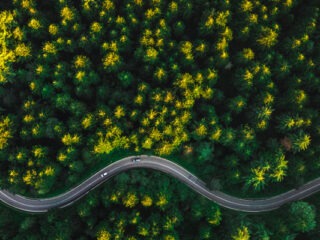Many different approaches are being used in the attempt to halt runaway climate change. Greta Thunberg has illustrated the power of peaceful protest, for example, while the steady drip-feed of climate-related books and articles aims to educate.
Climate litigation is becoming a key tool in the arsenal of climate activists. While this is still a relatively new field, people and institutions are increasingly turning to the courts in an attempt to alter the dynamics of the fight against climate change. As of the end of 2022, for example, the United Nations Environment Programme (UNEP) reported that there had been 2,180 climate-related cases filed in 65 jurisdictions, compared to just 884 cases in 2017.
This statistic was based on an innovative, open source database of climate-related cases compiled and managed by Columbia Law School’s Sabin Center for Climate Change Law. The Sabin Center’s mission is to be a resource for—and partner to—legal institutions engaged in work to counter climate change. The director of the Sabin Center, Dr. Maria Antonia Tigre, sat down with LEFF Sustainability Group to explain the definition and purpose of climate litigation (for more information, see the “About the Sabin Center and Dr. Maria Antonia Tigre” sidebar). She also talked about her passion for bringing more-diverse voices—including those from the Global South, women and children, and marginalized communities—to the fore.
About the Sabin Center and Dr. Maria Antonia Tigre
Created in 2009, Columbia Law School’s Sabin Center for Climate Change Law provides open-source, regularly updated resources on key topics related to climate law and regulation. The Center also develops legal techniques to support the fight against climate change and trains lawyers and students in their use. Project areas include energy law, environmental and land-use law, and international and foreign law, as well as cross-cutting issues and initiatives.
Dr. Maria Antonia is the director of global climate change litigation at the Sabin Center. With extensive experience in the field, she previously served as a senior attorney at the Environment Program of the Cyrus R. Vance Center for International Justice. During her tenure, she provided pro bono legal services to NGOs worldwide, focusing on issues related to protected areas and the intersection of human rights and the environment.
Karen Henrie: Can you give us a definition of the term “climate litigation” and describe your work at the Sabin Center?
Maria Antonia Tigre: My job is to understand how judges, courts, and other bodies around the world have interpreted all of the new and emerging obligations related to climate change and also to delineate the legal techniques that are being used in this area. My interest in this area is long-standing. I’m from Brazil, and that’s where I went to law school. My initial academic focus was on how the countries that share the Amazon Rainforest cooperate towards forest protection. That research evolved into a broader interest in the intersection of human rights and the environment and rights around access to a healthy environment.
The term “climate litigation” is still somewhat contested. At the Sabin Center, we define [climate litigation] as any judicial or quasi-judicial cases that specifically relate to climate change law or facts. We also include some administrative cases and investigations or complaints related to the United Nations or related bodies.
“At the Sabin Center, we define [climate litigation] as any judicial or quasi-judicial cases that specifically relate to climate change law or facts.”
One of my major tasks is to maintain our global database of all the key information about these cases, which is open-source and searchable. It’s not always clear which cases should be included in the database, but in general, it’s those that directly mention climate change laws or facts or that have a significant impact on mitigation or adaptation measures or on loss and damage. But we are conscious of the need to set clear and manageable boundaries. Casting the net too widely would make our job impossible.
Karen Henrie: What is the main purpose of climate litigation?
Maria Antonia Tigre: Climate litigation is very much about prompting action—pushing states or corporations to increase their mitigation or adaptation efforts and make sure that climate is considered during procedures such as environmental impact assessments and permitting. Activists are also increasingly using climate litigation as a tool to raise awareness of climate issues. At some point, we might also get to the stage of compensating victims, but we’re not there yet. In around 98 percent of cases, there’s no money involved, except perhaps to pay for adaptation measures.
About Into the Weeds
We at LEFF are, at heart, storytellers. We are dedicated to amplifying voices and causes from all over the world, regardless of gender orientation, race, or economic background. And the stories we tell as part of the Into the Weeds interview series are particularly important to us. We will be interviewing inspiring individuals whose work contributes to the achievement of the SDGs at every level; we’ll bring you insights from the leaders of global organizations, renowned experts and academics, and innovative local businesses.
Our goal for this series is the same one that underpins all of LEFF Sustainability Group’s client work: to use our storytelling skills to build awareness of the issues that threaten our planet and to draw attention to all the people, initiatives, and innovations that are fighting back.
Karen Henrie: According to your research, the total number of climate change court cases has more than doubled since 2017. To what do you attribute that growth?
Maria Antonia Tigre: That statistic is reflected in our database, which has become much richer in the last two years. We now have a network of volunteers and experts in climate change law and litigation who provide regular updates on developments in their jurisdictions, which has hugely increased the scope and richness of the data—though we still have a way to go, especially in Africa and Asia. The media is also much more aware of, and interested in, climate litigation, which makes cases easier to track.
But for the most part, the growth of court cases is a reflection of the current climate emergency. Climate litigation has become an important tool; it’s lengthy and costly, but it can be very effective. And each success adds momentum, although progress is uneven across the globe. The US still accounts for about 70 percent of cases, though the big, national cases that can have a systematic effect on climate change are often happening elsewhere. Arguably, the first big win globally was in the Urgenda case, in which the Dutch supreme court ruled that the government has a legal duty to prevent dangerous climate change, which had important implications for emissions reduction at the national level. There is now an organization called the Climate Litigation Network that aims to replicate the Urgenda approach within other legal systems.
More broadly, there’s still much more focus on the Global North within climate litigation, partly because of the historical responsibility of countries in that region. But the Global South is catching up as the effects of climate change continue to be felt, and we should expect the number of cases to continue to increase.
Karen Henrie: The Global South has been a major focus for you. Can you tell us a little bit about your work in that area?
Maria Antonia Tigre: I started the Climate Litigation in the Global South Project with Melanie Murcott, a professor from the University of Cape Town, in 2021. This project aims to decrease the gap between the amount of attention that climate litigation gets in the Global North and Global South—and to have more of the voices in the debate coming from the Global South itself. The project has been running for two years, and we’re just getting started. We’re in the process of publishing a special collection of the Journal of Human Rights Practice, which will contain 16 articles. Some of these articles are already available online.
The Sabin Center’s database also includes recent requests for advisory opinions on climate change. We currently have requests going through the International Court of Justice, the International Tribunal for the Law of Sea, and the Inter-American Court of Human Rights. In general, these procedures are brought by communities in the Global South looking to advance the law and clarify the climate-related obligations of states under international law. Once these advisory opinions are adopted, they can have a huge impact on climate litigation more generally.
Karen Henrie: Thirty-four cases have been brought by and on behalf of children and young people. How do children get involved?
Maria Antonia Tigre: Children can’t vote, but they will feel the greatest impact from climate change, which is why we have so many child activists. They see climate litigation as a tool for change. In general, they partner with NGOs, who bring cases on their behalf. These cases have been really effective because they can leverage laws related to the human rights of children specifically.
And children aren’t the only group that can be particularly vulnerable to the impacts of climate change. I think we’re going to see more cases related to, for example, women, indigenous groups, and other marginalized communities.
Karen Henrie: Do litigants ever face a backlash?
Maria Antonia Tigre: There have been many cases brought against climate protestors around the world, and our database also aims to track those. In some parts of the world, especially in Latin America, involvement in climate litigation can be dangerous. Litigants and lawyers can receive personal threats, including death threats. A lot depends on who they’re going up against.
Karen Henrie: Do funding limitations inhibit further use of climate litigation?
Maria Antonia Tigre: It’s definitely a big inhibitor because these cases can get very expensive, especially if scientific studies are needed. Big NGOs like Greenpeace and Friends of the Earth apply some of their funding to litigation, which is how many cases come about. There are also a number of newer foundations—including the Foundation for International Law of the Environment (FILE), whose entire model is to fund climate litigation cases around the world.
Karen Henrie: To finish up, do you consider climate inaction to be a violation of human rights?
Maria Antonia Tigre: I do, though it’s a controversial issue. What is no longer contested is that climate change infringes on a series of human rights, including the right to life, the right to health, and the right to a healthy environment. And climate inaction lends itself to these violations of human rights. Fortunately, we now have a number of climate protection frameworks, including the Paris Agreement and the United Nations Framework Convention on Climate Change, which contain specific obligations for states. It’s vital that we protect these frameworks and work to increase their ambition.
Behind the Scenes
This interview is part of LEFF’s Into the Weeds interview series—a series that amplifies individuals whose work contributes to the achievement of the United Nation Sustainable Development Goals (SDGs) at every level. We’ll be bringing you insights from renowned experts and the leaders of global organizations and innovative local businesses. Karen Henrie (she/her) is a senior editor for LEFF, and Clair Myatt (she/her) is the manager of LEFF Sustainability Group, for which Katie Parry (she/her) is the director.
Comments and opinions expressed by interviewees are their own and do not represent or reflect the opinions, policies, or positions of LEFF or have its endorsement.




Leave a Reply
You must be logged in to post a comment.